The Push-pull trains of Mumbai
The Push-pull trains with a WDM2 in the middle of a 6 or
10-coach rake are unique trains. The unmanned WDM2 is controlled
from large cabs in the end coach via the multiple unit cable.
I believed that the WDM2 is in the middle of the rake so as to
allow single driver in the cab, but all the push-pull trains (the
IR refers to them as 'DMU') have two drivers and a single guard.
However the Hubli - Dharwad DMU and Bangalore - Mysore DMU have
their locos at one end.
Some of the pictures below are by Shrinivas Joshi & Sarosh Mehta who along with Viraf Mulla went for a ride on
the Vasai Road - Diva Jn. DMU last year. The rest are by me shot on
the 1st of May 2001.
Some of the Godrej Gang
Meet some of the Godrej Gang - more railfans there than any
other part of Mumbai:
 |
Viraf with the DMU at Kaman Road on the Dombivali - Vasai
route. |
 |
Sarosh also poses. |
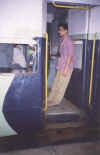 |
Shrivivas in the large cab, the parking brake wheel visible in
the background. |
View in and around the DMU
 |
The profiled face of the Diva Jn. DMU. |
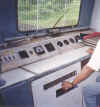 |
The driver holds the DMU in the 6th notch. The reverser is
below the throttle. The brake lever is below his right hand. The
switch bank on the left has the following functions: control on,
H/L (headlight), MUSD stop (stops the loco via the multiple unit
control) and G/F which is the generator field switch. The black
item after the switches is a hooter which sounds in case of any
fault. The red 'GB' lamp is the Generator Breaker closed indicator.
Next is the axle tacho-generator driven electric speedometer. After
that is the 'loadmeter' which reads the motor current in terms of
percentage load. There are time markings in the red zone which must
not be exceeded.The next four gauges are related to the air and
brake system, from left to right - brake cylinder pressure (BC),
master reservoir pressure, feed pipe pressure (FP) and the brake
pipe flowmeter with adjustable redline. You can see the wiper
mechanism, the thumbscrew near the flexible pipe adjusts the rate
of wipe. Also note the flags and the umbrella - this is the rainy
season! |

|
Shrinivas and Viraf watch the sunrise while we take opportunity
to study the chart listing the position of the MU valves. |
 |
Approaching one of the many bridges on the route. |
 |
The backwaters of the Ulhas river meandering through the
landscape. |

|
A look back at the pushing WDM2 amongst the lush
monsoon-inspired grass. |

|
A JNPT-bound container train crosses the DMU at Kaman Road with
a dual-voltage WCAM1 in charge. The Vasai - Diva section has large
facility which seems to aimed at the increasing JNPT traffic in the
future. |
My pictures of the DMU at Vasai Road station on the 1st of May
2001
 |
The DMU at Vasai Road waiting to depart towards Diva Jn. |
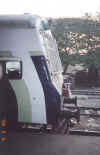 |
Matunga carshed at work? The profiling and the paint scheme
seems to be local decision. Note the swiveling bucket seats in the
huge cab. |
 |
View of the multiple unit connection between the short hood of
the Kalyan loco (# 18354) and the coach next to it. The MU cable
would travel over the roofs of three coaches to be led into the
driving cab at the end. The other cable appears to be the 110 V
lighting connections, although the normal inter-coach power
connection terminals are located below the cover with the yellow
paint in the right bottom corner. I am aware about the wrong date
stamp of the pics. |
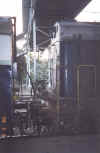 |
The long hood connection is also similar. |
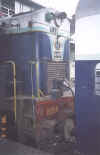 |
Is this a livery-matched locomotive? The Kalyan shed WDM2 #
18354. |
 |
The 9006 Up Okha - MCT Saurashtra Mail speeds through the main
line while the DMU waits on the BSR diversion track. |
 |
The DMU departs towards Diva Jn. after just an eight minute
halt. |
Dahanu Road - Virar DMU
 |
The 502 Up DMU arrives at the dead zone a few kms north of
Virar from Dahanu. The DMU is necessary as Virar and Dahanu are
charged to different catenary voltages. |
 |
The desperately overloaded train has people hanging everywhere.
The Vatwa shed loco is in the middle of 5 coaches on either
side. |
 |
Shrinivas steps from the swamp at the dead zone. |
 |
Approaching Virar, the WDM2 lets the world know its presence.
Note the sign 'DEAD ZONE ENDS'. |
 |
Later the same rakes returns as the 503 Down DMU towards
Dahanu. |
Dedication - Vasu
 |
Dedicated to the memory of my dear friend and fellow IRFCA
member, Dr. Vasudev Kamat - who did more railfanning in his short
years than many people can manage in their lifetimes.
|








